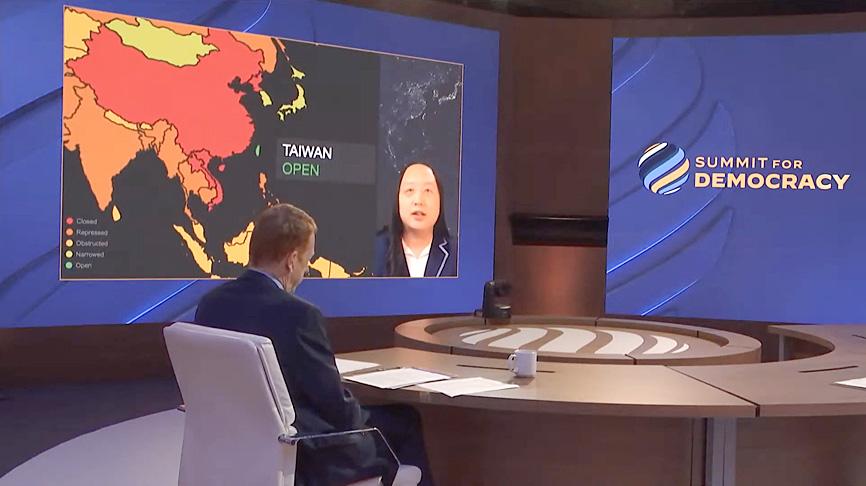A video feed of a Taiwanese minister was cut during US President Joe Biden’s Summit for Democracy last week, after a map in her slide presentation showed Taiwan in a different color to China.
Friday’s slide show by Minister Without Portfolio Audrey Tang (唐鳳) caused consternation among US officials after the map appeared in her video feed for about one minute, sources familiar with the matter said.
The sources, who did not want to be identified due to the sensitivity of the matter, said the video feed showing Tang was cut during a panel discussion and replaced with audio only — at the behest of the White House.

Screen grab from a Summit for Democracy livestream
The White House was concerned that differentiating Taiwan and China on a map in a US-hosted conference — to which Taiwan had been invited in a show of support at a time when it is under intense pressure from Beijing — could be seen as being at odds with Washington’s “one China” policy, which avoids taking a position on whether Taiwan is part of China, the sources said.
The US Department of State said “confusion” over screen-sharing resulted in Tang’s video feed being dropped, calling it “an honest mistake.”
“We valued Minister Tang’s participation, which showcased Taiwan’s world-class expertise on issues of transparent governance, human rights and countering disinformation,” a spokesperson said.
Tang’s presentation included a color-coded map from South African non-governmental organization Civicus, ranking the world by openness on civil rights.
Most of Asia was shown, with Taiwan colored green, making it the only regional entity portrayed as “open,” while all the others, including several US allies and partners, were labeled as being “closed,” “repressed,” “obstructed” or “narrowed.”
China, Laos, North Korea and Vietnam were colored red and labeled “closed.”
When the moderator returned to Tang a few minutes later, there was no video of her, just audio, and a screenshot captioned: “Minister Audrey Tang Taiwan.”
An onscreen disclaimer later read: “Any opinions expressed by individuals on this panel are those of the individual, and do not necessarily reflect the views of the United States government.”
The map generated an instant e-mail flurry among US officials and the US National Security Council (NSC) angrily contacted the state department, concerned it appeared to show Taiwan as a distinct country, one source said.
Washington complained to Taiwan’s government, which was angry that Tang’s video had been cut.
The source called the US move an overreaction as the map was not inherently about national boundaries, but the NSC was also angry as the slide had not appeared in “dry-run” versions of the presentation before the summit, raising questions as to whether there was intentional messaging by Tang and Taiwan.
“They choked,” the source said of the White House reaction.
A second source directly involved in the summit said the video booth operator acted on White House instructions.
“It was clearly policy concerns,” the source said. “This was completely an internal overreaction.”
The sources said they saw the move during a panel on “countering digital authoritarianism” as at odds with the summit’s mission of bolstering democracy in the face of challenges from China and others.
They also said it could signal that the administration’s support for Taiwan was not as “rock solid” as it has repeatedly stated.
Reuters’ account of the incident was “inaccurate,” an NSC spokesman said.
“At no time did the White House direct that Minister Tang’s video feed be cut,” the spokesman wrote in an e-mail, also blaming it on confusion over screen-sharing, and adding that the full video could be viewed on the summit Web page.
The Ministry of Foreign Affairs said yesterday that the US has blamed the incident on a “technical issue.”
Tang’s presentation had been provided in advance and was not shown at the last minute, the ministry said later.
“Taiwan and the United States have fully communicated on this technical issue, and the two sides have a solid mutual trust and a solid and friendly relationship,” it said.
Additional reporting by CNA

A magnitude 4.9 earthquake struck off Tainan at 11:47am today, the Central Weather Administration (CWA) said. The hypocenter was 32.3km northeast of Tainan City Hall at a depth of 7.3km, CWA data showed. The intensity of the quake, which gauges the actual effect of a seismic event, measured 4 in Tainan and Chiayi County on Taiwan's seven-tier intensity scale, the data showed. The quake had an intensity of 3 in Chiayi City and County, and Yunlin County, while it was measured as 2 in Kaohsiung, Nantou County, Changhua County, Taitung County and offshore Penghu County, the data showed. There were no immediate reports of

‘DENIAL DEFENSE’: The US would increase its military presence with uncrewed ships, and submarines, while boosting defense in the Indo-Pacific, a Pete Hegseth memo said The US is reorienting its military strategy to focus primarily on deterring a potential Chinese invasion of Taiwan, a memo signed by US Secretary of Defense Pete Hegseth showed. The memo also called on Taiwan to increase its defense spending. The document, known as the “Interim National Defense Strategic Guidance,” was distributed this month and detailed the national defense plans of US President Donald Trump’s administration, an article in the Washington Post said on Saturday. It outlines how the US can prepare for a potential war with China and defend itself from threats in the “near abroad,” including Greenland and the Panama

The Chinese Nationalist Party (KMT) is maintaining close ties with Beijing, the Democratic Progressive Party (DPP) said yesterday, hours after a new round of Chinese military drills in the Taiwan Strait began. Political parties in a democracy have a responsibility to be loyal to the nation and defend its sovereignty, DPP spokesman Justin Wu (吳崢) told a news conference in Taipei. His comments came hours after Beijing announced via Chinese state media that the Chinese People’s Liberation Army’s Eastern Theater Command was holding large-scale drills simulating a multi-pronged attack on Taiwan. Contrary to the KMT’s claims that it is staunchly anti-communist, KMT Deputy

RESPONSE: The government would investigate incidents of Taiwanese entertainers in China promoting CCP propaganda online in contravention of the law, the source said Taiwanese entertainers living in China who are found to have contravened cross-strait regulations or collaborated with the Chinese Communist Party (CCP) could be subject to fines, a source said on Sunday. Several Taiwanese entertainers have posted on the social media platform Sina Weibo saying that Taiwan “must be returned” to China, and sharing news articles from Chinese state media. In response, the Mainland Affairs Council (MAC) has asked the Ministry of Culture to investigate whether the entertainers had contravened any laws, and asked for them to be questioned upon their return to Taiwan, an official familiar with the matter said. To curb repeated